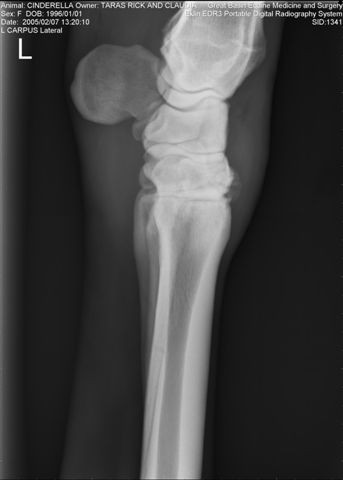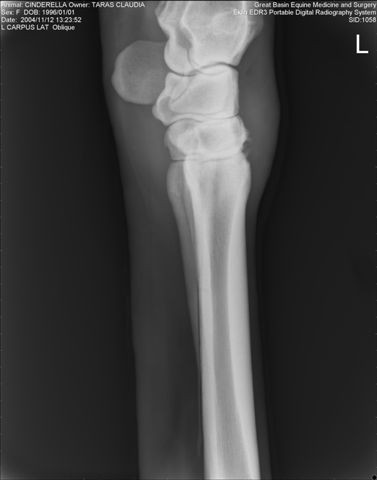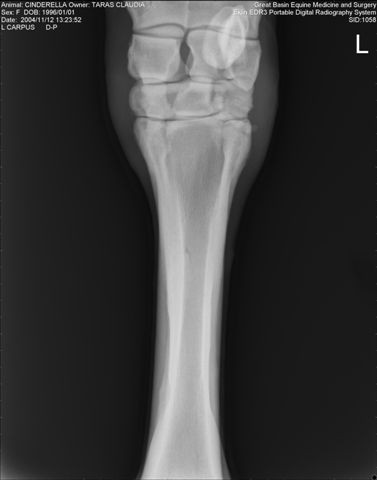Site Menu:
| This is an archived Horseadvice.com Discussion. The parent article and menus are available on the navigation menu below: |
| HorseAdvice.com » Diseases of Horses » Lameness » Diseases of the Upper Front Limb » Overview of Lameness of the Knee (Carpus) » |
| Discussion on Unusual exostoses on anterior surface of third carpal bone | |
| Author | Message |
| Member: Wolfydoc |
Posted on Tuesday, Mar 15, 2005 - 11:33 pm: DrO,My friend's horse had a front leg lameness localized to the knee based on swelling that came on over a couple weeks time and seemed worse on the posterior aspect of the knee. Pain on flexion. Initial radiographs showed nothing and ultrasound showed swelling of the carpal canal area. A repeat lateral radiograph about 2 months later (swelling completely gone) revealed some very unusual looking radiodense finger-like projections coming off the anterior aspect of what I think is the third carpal bone (I'm going off of memory after viewing the rads about 3 weeks ago). Another 2 months later the rough-edged finger-like projections had become totally smooth beak-like projections. I reviewed your anatomy article and lameness of the carpus but I can't figure out what this could be. The vet thinks it is trauma induced from the horse banging her leg on her stall door. To me it looks more like a torn calcified attachment of a ligament or tendon but I'm really guessing. Any ideas with my paltry description? Thanks, Cindy |
| Moderator: DrO |
Posted on Wednesday, Mar 16, 2005 - 8:15 am: DrC, can you better localize the projections? If along the distal border you could be right: there are ligaments that attach the third carpal bone to the metacarpal. If along the proximal border there are no attachments and traumatic injury or possible response to generalized inflammation in the joint (osteophytes) more likely. What I am trying to figure is what the relation of this is too swelling in the carpal canal...I believe the carpo-metacarpal joint has extensive exvaginations into the carpal canal based on the fact that you can inadvertently block the joint while attempting to block the insertion of the suspensory.DrO |
| Member: Wolfydoc |
Posted on Friday, Mar 18, 2005 - 11:50 pm: OK DrO,I've not been entirely truthful with you !  I didn't tell the whole story of the this horse's lameness because I was hoping it wouldn't be too complicated but now I'm going to complicate it even more for you! This horse had an extremely mild lameness at the trot last summer on the left front. She had nerve blocks and ultrasound indicating a proximal suspensory sprain. She was put in a stall 24/7 and started on a controlled exercise regimen. She was not happy about being stalled all the time and frequently kicked the stall door, or perhaps banged her knee on it? No one knows which. On top of this, she apparently had some very unusual reaction to the local anesthetic the day after nerve blocks - there was swelling up and down the entire posterior cannon area, and she was much more lame, even noticeable at a walk. Didn't seem to be infection, at least based on the vet's workup, but she was covered with antibiotics, at first trimeth-sulfa and then switched to Baytril, with no significant improvement. Over a period of weeks, the swelling seemed to travel proximally to the posterior knee, or maybe the posterior knee swelling was unrelated. Nothing specific could be identified on cultures, ultrasound, radiographs. Over a couple more weeks the swelling slowly resolved, and the lameness at a walk improved. The owner decided to let the horse back out in the pasture because of how maniacal she was in the stall. About two months after the initial lameness exam and workup, the second radiograph showed the exostoses, which I think were distal on the third carpal. The most recent ultrasound of the suspensory a couple months ago showed a good bit of healing, perhaps 85% better but still not normal. At this time her lameness is about what it was last summer, although she continues to show some difficulty getting up on that leg from a sternal position. Incidentally, the hair over the entire back of the cannon bone, which had been shaved for the very first initial ultrasound, has grown back white, and she is a black horse. Very odd story and it really confounded the vet, who is also my vet and I really respect him. THanks again, Cindy |
| Moderator: DrO |
Posted on Saturday, Mar 19, 2005 - 10:36 am: Wow that is quite a story. When the nerves where being blocked was there an attempt to block the origin of the suspensory? The reaction to the local and possible contamination of the carpo-metacarpal joint with a drug that she has an unusual reaction to might complete this story.By the way what local anesthetic was used at what concentration and was there epinephrine in it? DrO |
| Member: Wolfydoc |
Posted on Saturday, Mar 26, 2005 - 11:19 pm: Hi DrO,So appreciate your input. Yes the proximal suspensory was blocked. The vet who examined this horse is on vacation so I'll have to wait to find out what local was used. Another local vet who frequently refers to the original examining vet looked at the horse three days ago, got a very positive flexion test on the affected foreleg, and examined the radiographs. This second vet (who graduated a year behind me from Penn and ended up in Nevada also!!!) is at a loss as to exactly what is going on, but injected the carpus (I'm not sure which joint) with Legend and restarted Adequan. I'm hopefully uploading the radiographs for you. The original vet has digital technology and these were emailed to me from the owner, who is actually a member of HorseAdvice but is somewhat intimidated by the site! Cindy   
|
| Moderator: DrO |
Posted on Sunday, Mar 27, 2005 - 9:30 am: I think they are more likely to be osteophytes than enthesiophytes (though the upper one is questionable) DrC. I still think the scenerio I outline above the top of the list of probable causes.DrO |
| Member: Wolfydoc |
Posted on Sunday, Mar 27, 2005 - 2:35 pm: What would be your best guess as to the specific source of pain/lameness, assuming it is somehow related to the reaction, at this point in time, some 7 months after the nerve blocks? In other words, do you think there is still an ongoing active process or are we just seeing the radiographic end result? I'm just wondering if there's anything else besides Bute, Adequan, and IA Legend that could be done for the horse. This mare was my best friend's trail buddy extraordinaire, and my friend doesn't have any interest in a broodmare!Have you ever seen such a strange reaction to a local? Thanks so much for your help with this very weird case. Cindy |
| Moderator: DrO |
Posted on Monday, Mar 28, 2005 - 6:46 am: The ongoing lameness suggests a process that is still active and the radiographs definately indicate degenerative joint disease. IA corticosteroids would be the treatment of choice.No I have not seen such a reaction but in the human literature there have been reported reactions to local anesthetics, epinephrine, and the perservative in such preparations though they are rare. DrO |
| Member: Wolfydoc |
Posted on Monday, Mar 28, 2005 - 10:48 pm: Yikes! IA steroids. But that would only be a relatively short term remedy to allow the horse to still be worked, no? Or were you thinking in terms of stopping an inflammatory process that is ongoing? Excuse my limited understanding but I had the impression that IA steroids for treatment of DJD just buy some time and pain relief while not actually fixing the problem, and may even do more longterm damage if you do repeated injections?P.S. The local was carbocaine, no epinephrine. |
| Moderator: DrO |
Posted on Tuesday, Mar 29, 2005 - 8:33 am: If the problem is acute non-infectious inflammation I do not know of a better treatment and the quicker it is given the less permanant damage done to the joint. Whether the inflammation returns and how quickly will depend on the accrued damage of the joint: is it stable enough to work without becoming inflammed again?Of course corticosteroids don't cure degenerative joint disease, but it will address the acute inflammation and with judicious use slow down the chronic irreversible changes of DJD for a better outcome. For more on this see Equine Diseases » Lameness » Joint & Bone Diseases » Arthritis and DJD: An Overview be sure to follow the links where the use of steroids in joints is specifically discussd. I use carbocaine and as stated earlier have never had such a reaction. DrO |
| Member: Wolfydoc |
Posted on Tuesday, Mar 29, 2005 - 5:40 pm: That all makes total sense. Thanks so much DrO. I will go to your sites and read up! I'll let you know what happens at her recheck tomorrow.Cindy |
Horseadvice.com
is The Horseman's Advisor
Helping Thousands of Equestrians, Farriers, and Veterinarians Every Day
All rights reserved, © 1997 -
is The Horseman's Advisor
Helping Thousands of Equestrians, Farriers, and Veterinarians Every Day
All rights reserved, © 1997 -
